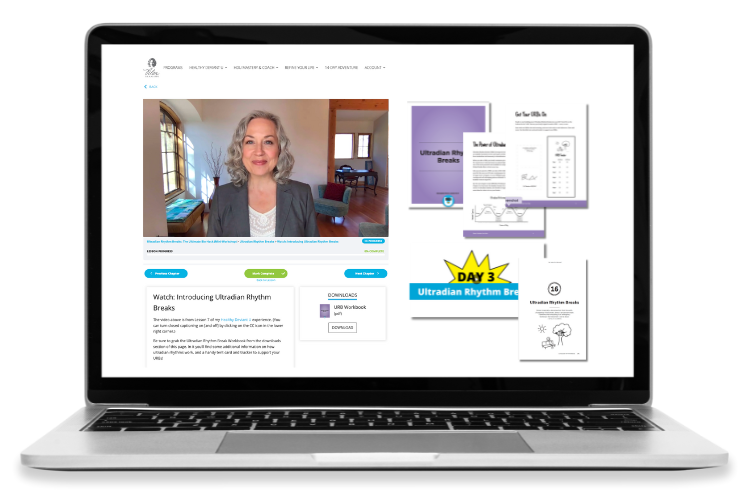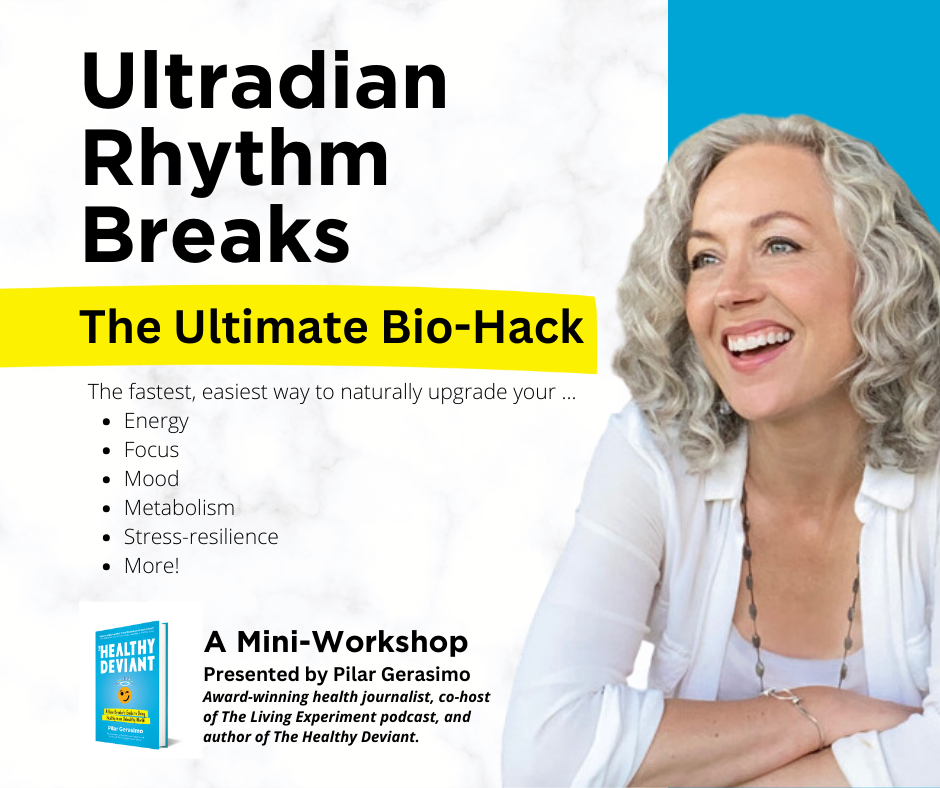
I talk about ultradian rhythms a lot. Because they matter a lot. Far more than the health media ever reflect, far more than most doctors know, and far more than most people realize.
In fact, as healthy living skills go, I would say noticing and managing your ultradian rhythms likely ranks in the top five most important things you can do for your wellbeing. That’s why I include them as one of three key Renegade Rituals in my book, The Healthy Deviant, and even created an available-anytime mini-workshop on the topic: “Ultradian Rhythm Breaks: The Ultimate Bio-Hack.”

Ultradian rhythms are natural, undulating cycles of energy — oscillating patterns of energy production and recovery — that occur in people (as well as in other living things) many times throughout the day. Like circadian rhythms, but smaller.
The basics: After 90-120 minutes of sustained energy output and mental focus, the body and brain need a 15-20 minute break. Your systems use that down time for recovery, repair, replenishment and rebalancing. After which time, they return to a high level of productivity and efficiency for another 90 to 120 minutes.
On paper, it looks like this …

How We Get Worn Down
If we refuse to take a break when we need one, bad things happen. The byproducts of productivity build up in our system, creating high levels of stress and fatigue.
We get groggy and distracted. Bodywide inflammation rises, immunity drops, mental capacity, metabolism and mood all suffer. We can’t think as straight, so our error rate increases and our productivity plummets.
In other words, we start getting significantly diminished returns. And the more ultradian rhythm breaks we skip, the worse the damage becomes.
Many people react to their body’s “need a break” signals by taking a coffee or cigarette break or eating sugar. While these solutions provide temporary relief (sugar and coffee work by forcing the system into a momentary energy spike; cigarettes by blunting feelings of emotional stress and reactivity), they establish unhealthy dependencies, and none of them supply the physiological recovery and repair opportunity the body and brain are really looking for. Accordingly, they don’t return the body and brain to a state of optimal function.
For that, you need an ultradian rhythm break, or what I call a “URB.”
How To Take an Ultradian Rhythm Break
So, how does one take a proper URB? According the research (much of which has been done by the U.S. Department of Defense), the best way is to lie down, preferably in a dark, quiet room, and take a mini nap.
But you don’t have to actually nap (or even lie down) to have it count. Not even close. Reclining, sitting, leaning or moving calmly (e.g., walking, doing yoga, or tai chi) are all good options. The main thing is to free your system from stress, to let your body relax or change positions, and to let your mind wander or be calm.
Any mental and physical break, or even a shift of focus to something different and less demanding, is better than nothing. And any quality time spent taking a URB better than none.
Here are some great ways to take a URB (feel free to mix and match for a total of 20 minutes, or for however long you can manage):
- Hit the restroom (even if you don’t think you have to go)
- Get a drink of water or cup of tea
- Grab a healthy snack (avoid refined carbs and sugars)
- Get outside and walk calmly
- Stare into space
- Close your eyes and meditate or do deep breathing
- Sit on a curb or bench and let your mind wander for a while
- Walk around the building
- Visit with a colleague or friend
- Listen to a guided meditation or piece of calming music
- Do a little restorative yoga (shivasana is highly recommended)
- Do a mindless task, like refilling your stapler or cleaning out your purse
- Run a simple errand
- Make dinner reservations or book an oil change
- Call a loved one to say hi, or to tell them you love them
- Visualize how you want the rest of your day or evening to go
- Make a quick list of things you are grateful for
What you don’t want to do is more of whatever you’ve been doing for the past couple hours, especially if that’s looking at some kind of screen. You need a gear shift, a reboot, a change of scene.
Go Deeper on Ultradian Rhythms
Want to dig deeper into how ultradian rhythms work, and why they matter so much to your health, happiness, performance, and whole-person wellbeing?
Consider taking my mini-workshop on ultradian rhythms (“Ultradian Rhythm Breaks: The Ultimate Bio-Hack”), where I explain all of that and more — AND give you some handy tools to begin integrating Ultradian Rhythm Breaks into your life.

You might also want to read my book, The Healthy Deviant: A Rule Breaker’s Guide to Being Healthy in an Unhealthy World, where I devote a whole chapter to ultradian rhythms while also giving you a little toolkit for integrating them into your life.
Dallas Hartwig and I did fun podcast on ultradian rhythms a while back, titled “Pause” (it remains one of my favorite The Living Experiment episodes ever).
Finally, if you want to dig deeper into the science on this topic, I strongly recommend Ernest Lawrence Rossi, PhD’s book, The 20 Minute Break. Rossi is one of the world’s leading experts on ultradian rhythms (he has written or contributed to a slew of other research books on the subject), and while this book dates from the early 1990s, it remains one of the best topical resources aimed at a lay audience.
Want more life-shifting wisdom?
Check out my book, The Healthy Deviant: A Rule Breaker’s Guide to Being Healthy in an Unhealthy World. You can get a free preview and find purchase links here. Thank you for supporting my work!



12 Comments
Hi Pilar!
I am so happy to see all that you have accomplished! I love your story & do remember you writing when I lived at Bubbling Spring,
20 years ago! You are such an inspiration! Keep up the great work!! I love reading your writing’s and learning from you! Thank You!! Cee
[…] Gerasimo in this article would say that noticing and working with our Ultradium Rhythms is essential for health and […]
[…] Ultradian Performance Rhythm graph image courtesy of Pilar Gerasimo […]
[…] room improves her ability to concentrate and do deep work. She also noticed that when she needs a true break from work to rejuvenate, she reaches for her phone (which isn't rejuvenating) instead of doing some […]
[…] Laura writes about this in her books – taking breaks increases energy. “Powering through” without a break depletes energy, focus, and productivity. (Resource: Ultradian Rhythms). […]
[…] Laura writes about this in her books – taking breaks increases energy. “Powering through” without a break depletes energy, focus, and productivity. (Resource: Ultradian Rhythms). […]
[…] Pilar explains it in her brilliant, super helpful blog from 2016: […]
[…] I wrote this post about ultradian rhythm breaks and also included them one of three Renegade Rituals in my new book, The Healthy Deviant: A Rule […]
[…] Over the previous week, I’d flown across a few time zones. I’d skipped some meals. I’d skimped a bit on sleep. I’d had a couple extra glasses of wine. I’d done an unusually intense workout. I’d definitely neglected to take a lot of my daytime ultradian-rhythm breaks. (For more on those, see “All About Ultradian Rhythms.”) […]
[…] If you want to read more about ultradian cycles, click here. […]
[…] Ultradian Rhythms […]
[…] Source: Why You Need To Unplug Every 90 Minutes The Origin of the 8-Hour Work Day and Why We Should Rethink It ALL ABOUT ULTRADIAN RHYTHMS […]